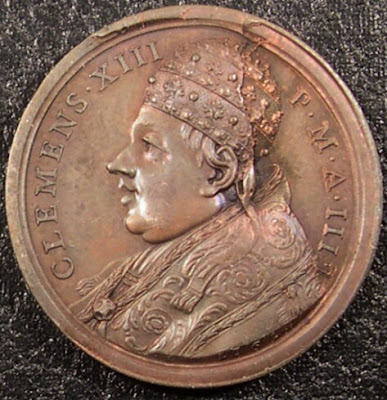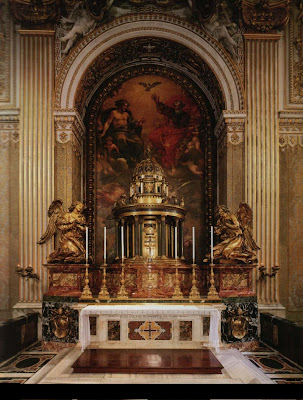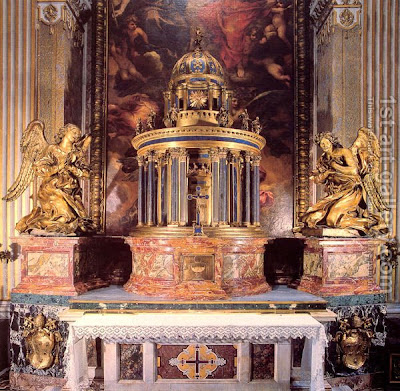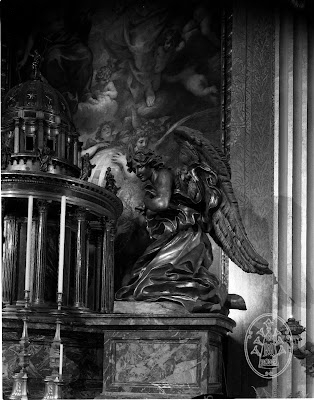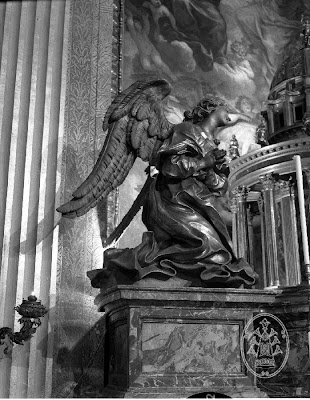 Interior of San Carlo alle Quattro Fontane, Rome. The high altar painting "St. Carlo Borromeo contemplates the Holy Trinity with Sts. Jean de Matha and Félix de Valois" is by Pierre Mignard.(7 November 1612 - 30 May 1695)
Interior of San Carlo alle Quattro Fontane, Rome. The high altar painting "St. Carlo Borromeo contemplates the Holy Trinity with Sts. Jean de Matha and Félix de Valois" is by Pierre Mignard.(7 November 1612 - 30 May 1695)
We are about to be deluged with Baroque
Waldmar Januszczak is presenting a short BBC series entitled
Baroque! From St Peter’s to St Paul’s starting on Wednesday at 9pm on BBC4.
The Victoria and Albert Museum in London is hosting an exhibition on a similar theme entitled
Baroque 1620-1800: Style in the Age of Magnificence from 4 April to 19 July 2009.
Baroque was the first "global style": the first style to have a significant worldwide impact.
It spread from Rome then the whole of Italy and France to the rest of Europe. Then it travelled to Africa, Asia, and South and Central America via the colonies, missions and trading posts of the Portuguese, Spanish, Dutch and other Europeans. The style was disseminated through the worldwide trade in fashionable goods, through prints, and also by travelling craftsmen, artists and architects
The patronage of the Roman Catholic Church was fundamental to the Baroque.
Baroque religious art was designed to move, impress and please the beholder.
Performance was as prominent in the sacred spaces of chapels and churches as it was in the theatres. Religious processions, church services and other rituals were designed to maintain social cohesion as well as offer a route to personal salvation.
This ability of the Baroque style to communicate effectively and immediately with audiences of all kinds, and in a range of situations, made it a powerful tool in the organisation of sacred ritual.
The Baroque style employed painting, sculpture, architecture and the applied arts in tandem with other arts such as music and poetry. The aim was to appeal to all the senses.
Seeking a combined and integrated effect, these total works of art sought to affect not only the hearts and minds of onlookers, but also to touch their very souls
Waldmar Januszczak, also the art critic of The Sunday Times, writes enthusiastically about the Baroque and his series about to be televised:
"Art movements can be tiny and over in a flash.
Vorticism, for instance, was invented by a few chaps in London in 1913, had one exhibition and petered out by 1915. Its influence was negligible. At the other end of the scale, however, among the behemoths and the leviathans, there are art movements so big that it is fairer to call them global convulsions. Gothic, for one, was an epidemic that spread across most of the known world. Our own conceptualism has washed up pretty much everywhere because of the ubiquity of the internet. When it comes to longevity as well as size, though, there has never been anything to match the baroque age. In the ranks of the big art movements, the baroque is the diplodocus, the blue whale, the Fred Goodwin pension.
So, when the BBC approached me about encapsulating its achievements in a three-part series, my first instinct was to laugh in Auntie’s madly optimistic face. The baroque in three films? That is like putting Everest in your garden. Or encapsulating Hamlet in a haiku. It cannot be done. Even Jeremy Paxman has been given four hours in which to twitter on about the Victorians. And the Victorians accomplished mere thimblefuls compared with the baroque. They gave us William Powell Frith; the baroque gave us Rembrandt, Velazquez, Rubens, Caravaggio, Vermeer, Van Dyck, Bernini, Bach, Handel, Purcell, Wren. Dammit, even Shakespeare was a baroque figure. Yet, unrealistic as the task indubitably appeared, it had to be attempted. Real arts television — as opposed to the sort featuring a clipped-on presenter from another field — gets so little airtime in today’s graceless TV schedules that all available straws need to be grasped. The herd of elephants had to be squeezed into a Mini.
The name “baroque” actually comes from a Portuguese word, barroco, which means “a misshapen pearl”. So the type of beauty it describes was blobby and bulging, rather than symmetrical and round. All that tells us about the baroque is that it had an indefinite outline, the result, I suggest, of trying to stuff so much into it. Two of the baroque’s dimensions were particularly spectacular. The first was its reach. At one end of its penetration, it became the house style of the whole of Latin America; going the other way, it travelled as far as Macao, in China. This was the first truly global art movement.
What’s more, it refused to confine itself to the usual art forms. Yes, it revolutionised painting, sculpture and architecture, as you might expect, but the baroque also changed the history of furniture-making, stucco, marblework, glass production and every other creative territory. Music was merely one of its wider highways, yet it invented operas, virtuosi, concertos, sonatas, guitars, violins and orchestras.
The baroque’s second outstanding quality was its time span. It started in Rome at the end of the 16th century, when Caravaggio appeared on the scene, but by the time the wildfire was spent, we were halfway through the 18th century. In Britain, where it arrived characteristically late, it didn’t get fully into its stride until Britain’s greatest baroque achievement, St Paul’s Cathedral, was finally completed in 1710.
So we are talking here about nearly two centuries of intense artistic accomplishment in every creative direction.
The obvious route through this gigantic continent of art — starting at the beginning and following the story through to the end — would have taken 20-30 films. So I needed to find a short cut, a theme, a trajectory. I beat myself up over this for many weeks and finally decided to confine my investigation to a short but pertinent leg of the journey. If I began outside St Peter’s, in Rome, I calculated, in that magnificent enfolding colonnade designed by Bernini in the 1650s, which holds three times as many people as Wembley stadium and seems to give every one of them a big baroque bear hug, and ended up outside St Paul’s a century or so later, staring up at the false dome, designed by Wren, that makes the cathedral look so much taller than it actually is, I could deal with most of the baroque’s main drives: its illusionism, its sense of movement, its ingenuity, its ambition, its sheer wackiness. And I would end up in Britain, where it had some of its finest yet least regarded moments.
Take the 51 city churches that Wren designed for Charles II. Most of them are still standing, and they surely constitute the finest concentration of baroque architecture outside Rome. People ought to be banging on about them endlessly, but for some modest British reason, they don’t. Or that thrilling riverside vista at Greenwich, with Inigo Jones’s Queen’s House in the centre and Wren’s Royal Naval College on either side. What a stupendous view. Rubens’s painted ceiling for the Banqueting House in Whitehall — his only surviving painted ceiling — is also a British baroque achievement, and then you get the fabulous arrival here of Van Dyck, with all that he invented. Tracing the baroque’s journey from Rome to London would take me past a dense cornucopia of treasures.
As it happens, 2010 is the 300th anniversary of the completion of St Paul’s, and as I love that bonkers building with a passion, the stars seemed favourably aligned for the Rome-to- London approach. So I got myself a fine baroque map of the world, published by the great Willem Blaeu in 1635, and set about deciding which bits of that world I could afford to ignore. I needed to be ruthless. The whole of Latin America had to go. Russia went. Central Europe went. And Germany. The hardest omission, though, was France. Having only recently stopped drooling from a chronic attack of bling rabies, triggered by a fabulous display of baroque silver at Versailles, I was grimly aware of France’s enormous contribution to the age. But three films is three films.
Fortunately, the baroque helped me out by proving so convincingly in its own glorious history that size does not always matter. I mean, look at Vermeer. His pictures are about as big as a kid’s exercise book, but what a fierce emotional wallop they pack. And one of my favourite baroque buildings in the world, the church of San Carlo alle Quattro Fontane, in Rome, by Francesco Borromini, is crammed into such a tiny Roman corner that a half-decent long-jumper would easily clear the entire complex: church, sacristy, monastery and cloister.
That said, the baroque definitely liked bigness. Some of its most spectacular achievements, from Padre Pozzo’s illusionistic heaven in Sant’Ignazio, in Rome, to the huge, militaristic facade of Blenheim Palace, behind which Winston Churchill was born, are XX Large. The quest, therefore, was to identify a defining quality, and to understand how this defining quality could lead to a massive, nude-strewn Rubens ceiling at the same time as it gave us a tiny still life of a cabbage and a lemon by the quiet Spanish genius Juan Sanchez Cotan. What drove the baroque? What united its madly varied international strands?
To answer that, I went back to the start and stared my eyes out at Caravaggio. Whatever Caravaggio was trying to do, I reasoned, the baroque in general was probably trying to do.
Now, the problem with Caravaggio is that the modern world has misunderstood him grotesquely. Ever since Derek Jarman whipped off his top in a ravishing but thoroughly misleading film biography, Caravaggio has been mistaken for a knife-loving, sadomasochistic Roman crazy. It’s a classic case of exporting crude modern preferences into the past. If, however, you look properly at Caravaggio’s Supper at Emmaus in the National Gallery, or the soulful Madonna di Loreto in Sant’Agostino, in Rome, you clearly find yourself in the presence of an intense and proselytising Catholic believer: a religious genius who hunts you down with predatory skill.
By setting his action in the shadows of the night, by using real people for models, by making his saints so touchable, Caravaggio plucks religious art out of the middle distance and shoves it under your nose. First he gets close to you, then he gets into you.
This revolutionary approach — the opening salvos of the baroque — can be traced back to the great Catholic council that convened in northern Italy in 1545 specifically to find ways of battling Protestantism. The Council of Trent had as its overriding aim the reconquest of the Christian soul. It specifically instructed Catholic artists to involve themselves in this struggle. Yet it wasn’t until Caravaggio finally appeared, half a century later, that a genius of the appropriate heft actually took up the cudgel.
You may be wondering what any of this has to do with St Paul’s, or Vermeer, or a Spanish still life? A lot, as it happens. When the Council of Trent urged its artists to involve themselves in the hunt for the human soul, it was actually urging them to grab an audience. Earlier art movements were merely concerned with producing the best art; the baroque needed also to have that art noticed. And there are, of course, different ways of getting noticed.
The baroque liked big things because big things are unmissable. Rembrandt comes over all vulnerable on us because vulnerability presses our sympathy button. Padre Pozzo’s huge illusionistic ceilings wow us with their miraculousness. Velazquez's royal portraits play psychological ping pong with us, confronting us with kings so present, we can touch them.
As the baroque spread and drifted and expanded, it forgot the origins of its religious message and began working for emperors as well as popes, Protestants as well as Catholics. The ideas that drove it proved useful in all manner of hands. And the arts, I suggest, have also never forgotten that driving idea: if you want people’s attention, you need to grab it."
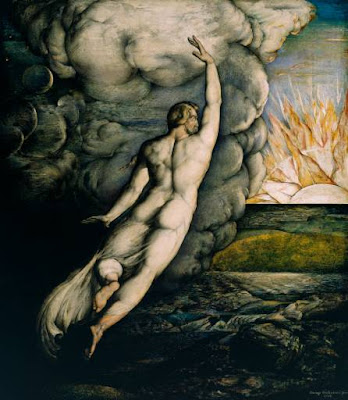 George Richmond 1809-1896
George Richmond 1809-1896













